Tobruk part four: The Easter battle
"Heaven help any force which meets those wild Western Australians. It is not fair to let them loose in a war." - Australian artillery officer (unknown) 1941
The Australians along with a scattering of other Allied elements had taken Tobruk from the Italians however the Axis forces wanted it back; The port was critical to their desert war. After a fierce but short battle the town had been taken and the Aussies (Diggers) laid plans for its defence which included, quite literally digging in. Attack, counter-attack, dig, attack, counter-attack, dig...Rommel and the Afrika Corps made their lives hell but the Diggers gave them some hell right back in true ANZAC spirit.
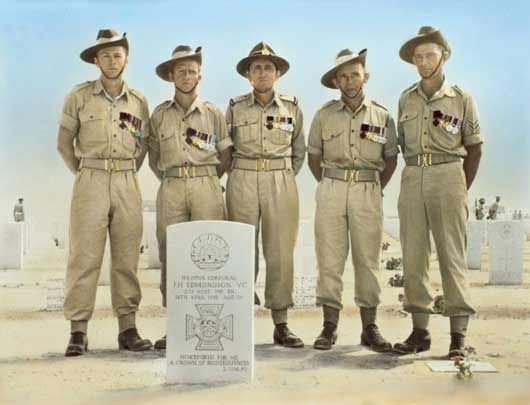
Tobruk was now surrounded South, East and West with the Mediterranean sea to the north. Each of these Axis elements probed and feinted along the perimeter to keep the defenders on edge and guessing where the main thrust might come. For the attackers and defenders both life was a series of baking-hot days, cold nights, artillery bombardments, firefights and dangerous night-ops all conducted by men fuelled on the odd can of bully beef or hard-tack and a few mouthfuls of water. (Hard-tack is a hard biscuit made from white and wholemeal flour, sugar, salt, powdered milk and water. They had a long shelf-life and did not require refrigeration...And tasted like shit.)
The men on both sides were fatigued. The Australians had conducted a fighting retreat back to Tobruk after a series of probing attacks against a confident and extremely well led and equipped force and both sides knew there was a lot of killing ahead of them.
On the 11th of April Tobruk was cut off by land and the siege began. A point to note here is that the siege was not a true siege as the Australians were supplied via the port however supply was sporadic, problematic dangerous and unreliable.
Soon after the town being cut off Rommel called the attack and the tanks rolled. The old Desert Fox used an age-old tactic of having his rearward forces stir up dust giving the defenders the illusion of greater forces and the 5th Panzer Division rolled hot into the southeastern perimeter of Tobruk drawing heavy fire on the tanks and infantry following behind. Artillery screamed over from the within Tobruk as the batteries opened up on the attackers. Even the ground itself seemed to aid the defender's artillery shells with rocks becoming deadly shrapnel with each landing shell. The Panzer's probed the anti-tank ditch searching for an opportunity but the defenders poured on accurate fire and left them mangled and smoking.
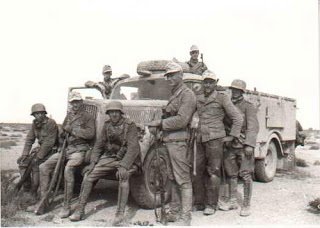
Still they came; The Germans. On one occasion a group of 700 of them approached and facing them were 2 Bren gunners and 24 riflemen from Australia. The Aussies poured a murderous fire into the Germans who could only try and scratch a depression into the hard ground in a bid to survive. Doggedly the Germans scratched their way forward though and poured fire on the defenders in return. They cursed the Aussie snipers (scharfschützen) and their accuracy as they last many men to them. Bravery in battle comes in many forms but none more than the battlefield medics two of which simply stood and began to drag the German wounded to the rear. Miraculously they were not killed and so continued their work. Chivalry on the Aussies part or luck? The medics were untouched but the attacking troops were being decimated. The soldiers reached a point a few hundred yards from the perimeter and were halted there by overwhelming fire, lack of cover and lack of tanks. Lying there, rounds grazing the tops of their helmets, in the brutal sun with no water more than a few of them probably wondered just where their tanks were. They remained there for two days until the next German attack.
There was no time for a breath for the defenders of Tobruk though as seventy Panzers and Italian M31 tanks rolled on firing their 75mm canon and machine guns. The Australian 2/17th defended as best they could and thanks to a group of four British tanks were able to turn the attack in the failing light.
The siege of Tobruk was not simply a battle between entrenched defenders and a mobile besieging force. General Morshead commanding officer of Tobruk ordered an aggressive series of patrolling in the anti-tank ditch and beyond the wire with orders to attack and harass the enemy where possible all the while the engineers spent each night laying more mines for the enemy tanks and men to encounter in the morning. These patrols often meant brutal hand to hand combat between the forces as opposing patrols would encounter each other.
On Sunday the 13th (Easter Sunday) the defenders heard a plane and looked skyward. Spiralling overhead was a German plane. Soon after leaflets began to flutter down and on inspection they found written there a request for a formal surrender. Now, the Australians knew the Germans were yet to launch their main attack however they were in no mind to surrender and so put the paper to good use; In the latrines.
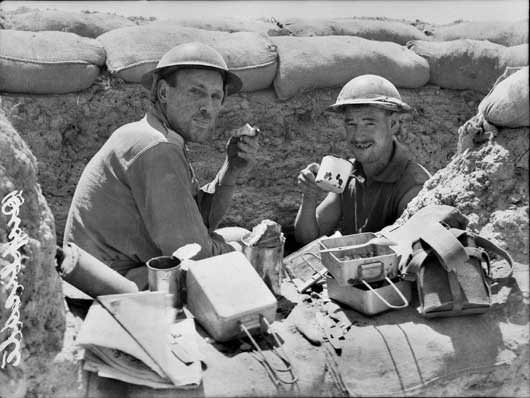
Another attack came that day and the artillery saw them off however the German forces were building and the defenders knew a major push would happen sooner rather than later. The German's hadn't used their bombers or Stuka's as yet either. A couple of days after the initial attack and the battle was just starting to brew.
By Monday morning the Germans were about to break through. The previous night's actions had been fierce and especially brutal with both sides fighting tank to tank and hand to hand with bayonet, rifle and hand grenade. The Germans pushed hard and broke through in places but the defending posts rallied and counter-attacked driving them back or eliminating them with the aid of British tanks and some well-placed artillery. Rommel was single-minded though and pushed the attack despite reluctance and even verbal disagreement from some of his officers, General Johannes Streich among them! Rommel was certain the defenders were evacuating and his battle plan reflected that assumption being sporadic and lacking the focus required to actually punch through what were enthusiastically defended perimeters.
The Germans break through
For the entire war the German tank Divisions based their strategy on applying overwhelming force to a small front punching through and driving deep and fast into the enemy's soft underbelly. Once the tanks had punched through and driven on through what was supposed to be a decimated and demoralised defender the infantry would pour through and subdue any forces left with any fight in them.
The first part worked this time with the tanks driving right through the perimeter and into the rear with seemingly no resistance. Off they went kilometers away behind enemy lines and in poured the infantry on their tails...But where were those mad, insane, crazy, murderous Australians they thought...
The tanks burst through the line, the ground shook, dust flew...Keep your bloody head down ya bastards! said an Aussie Sergeant to his men. Tracks rolled over slit trenches hastily dug over the last few nights, sand rocks and dust fell, eyes squinted, handkerchiefs covered mouths...Keep your bloody head down and keep quiet. The noise of the tanks started to subside but the dust didn't and a new sound came to their ears...Talking. The German infantry were pouring through behind the tanks. Shh, quiet you idiot!...
General Morsehad had designed a trap you see. Let the tanks in, let them drive deep into our territory as Rommel likes to do, let the infantry follow up thinking the enemy was beaten and then close the trap.
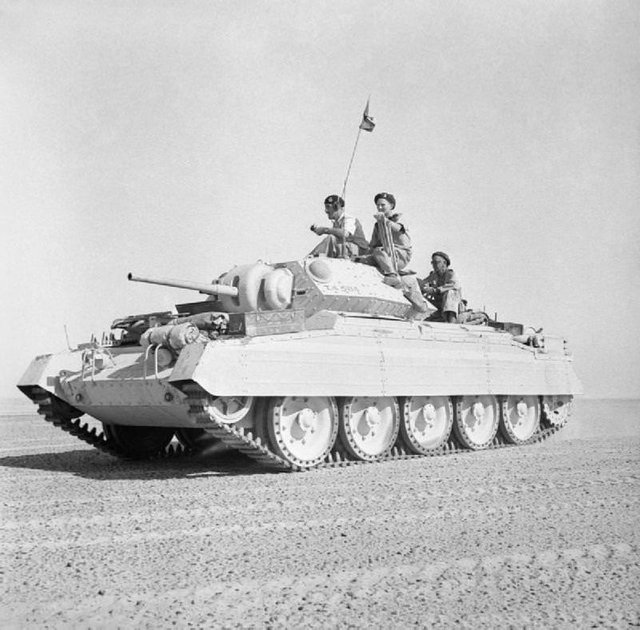
...The Aussies burst forth from their trenches and set upon the Germans with rifle, machine gun, bayonet and hand grenade. They were taken by surprise and with the support of a hand full of British Matilda and Crusader tanks they were either killed or captured in droves. As for the German tanks that had left their men so exposed 17 of the 38 were destroyed by the Allies. The viciousness of the attack had taken the Germans by surprise and the order to retreat was called quite quickly. If it had not they would have lost their full force. As it was they lost 17 tanks, 4 Stuka's, 150 dead, 500 wounded and 250 taken prisoner. The Allies lost 26 dead, 64 wounded and 2 tanks. You can see a Crusader tank to the right manned by its British crew.
Several other attacks were conducted but the defenders repelled them. One involved the Italians on the 15th and 16th of April. Three Bren machine-gunners were wandering about in no-mans-land when up ahead of them they saw a battalion of Italian soldiers coming their way. They turn-tailed and hot-footed it back to the defensive perimeter to warn their mates. Within minutes every man who could carry a weapon was on the line waiting for the attack, and sure enough, here it comes...
...Just behind the Italians were 12 Panzers and...It looked like they were herding the Italians? All of a sudden the battalion started running towards the perimeter but...wait...They were throwing down their weapons and raising their arms! Surrender! The German tanks paused for a moment and then opened fire, into the backs of the Italians. The Aussies opened up at that point and drove the tanks off. They were left with 3000 more mouths to feed; 3000 more Italian prisoners.
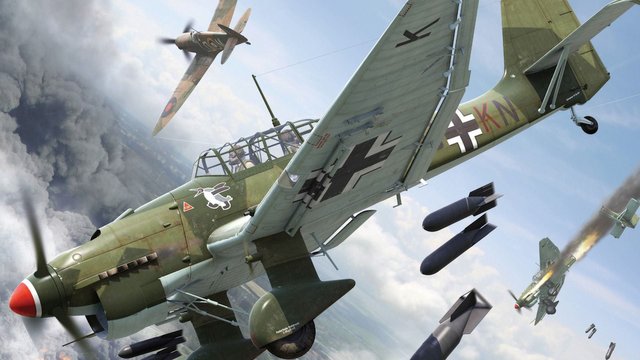
Back in the German rear Rommel was visiting the 8th Machine-gun battalion. They arrived in Africa with 1400 men and after the recent battle and numerous other actions now numbered 300 men. His offensive was not going to plan and there were rumblings back in Berlin, rumblings of dissatisfaction.
The Tobruk defenders had thwarted every attempt Rommel had made to dislodge them but they had suffered losses too. Now they would have to endure days of artillery and bombing as waves of 40 bombers and Stuka's (pictured) at a time flew overhead and pounded the small town. Artillery sent shells over day and night.
The battle was building and had not yet met its crescendo. Rommel needed success, the defenders needed supplies.
I'll leave you with a quote by General Leslie Morshead:
Battles and campaigns are won by leadership – leadership not only of senior but of junior commanders - by discipline, by that knowledge begotten of experience - knowing what to do and how to do it – and by hard work. And above all that, by courage, which we call guts, gallantry and devotion to duty – General Leslie Morshead, Commanding Officer, Tobruk.
-[ Design and create your ideal life, don’t live it by default - @galenkp ]-
Read part one
Read part two
Read part three
Stuka image source
Crusader tank image source
Afrika Corps soldier image source
Aussie soldiers image source
Great story of the rats of Torbruk. My grandfather who was a veteran of WW1 was a sergeant in one of the Italian POW camps in country NSW during WW2.
Thank you Stephen. I have now placed links to parts 1-3 if you are interested. Respect to your grandfather who served.
Part 4! I figured I had missed it. That was a good one. They really dug trenches in the ground and let the enemy go over them? And the Germans really opened fire on the Italians when they wanted to surrender?
I'm learning so many new things.
Yep, the besieged troops in Tobruk had to get innovative and due to Rommel's tactic of punching through the enemy and them driving deep into their rear they figured they could use the tactic to lay a trap. It was a risk though although General Leslie Morshead had little choice but to think outside the square. I am sure there were heroes and villains on both sides of the Easter battle however it was win or lose Tobruk for the Allies. Fortunately they won the day.
The tactic has been used to great effect right throughout history where the centre, or one of the flanks would collapse drawing the advancing enemy into a trap. I believe Alexander the Great used it several times also as did many other military commanders also I'm sure.
On the Italians: Yes, the 12 Panzers opened up into the backs of the Italians and also at the Aussies on the defensive perimeter as well. Unfortunately most of the Italians weren't strong believers in the cause and were there under sufferance and threat. It's a pity many died whilst being herded into battle by the German's however their country were tied to the Axis forces through Mussolini and so they had little choice. Fight or die regardless.
It's amazing how sometimes one general can change the course of a whole battle, or even war because of his ability to see the situation differently than anyone else.
Did the Italians use conscription to raise their troops? Or is that too obscure a question?
I believe they were however at the time (WW2) compulsory military service was enforced (2 year periods) in Italy. Also, during Mobilisation those who had served previously were called back in and kept in until they were no longer needed. Compulsory military service is a feature of quite a few countries to this day. I believe conscription was scrapped several years ago in Italy though.
I figured there was. That would suck to get called back up when you had already done your time. It's normally not a popular thing, so not surprising they got rid of it.
excellent history, you wrote for us dear@galenkp
Only my aunty calls me dear, mate.
oh, i am extermly sorry, i do no want to hurt you,
so sorry @galenkp